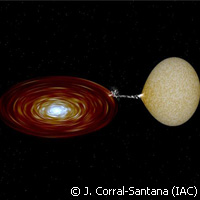Astrophysicists confirm black hole tops solar mass
Groundbreaking research from the Instituto de Astrofísica de Canarias (IAC) confirms what astrophysicists have long believed: the existence of a black hole that is 5.4 times greater in mass than that of the Sun. The black hole is located in the X-ray binary system XTE J1859+226. The finding has been published in Monthly Notices of the Royal Astronomical Society (MNRAS). To date, scientists have discovered around 20 binary stellar systems containing a black hole, a small number considering the estimated population of some 5,000 in the Milky Way Galaxy, the home galaxy of our Solar System. X-ray binaries are stellar systems made up of a compact object - that could either be a black hole or a neutron star - and a 'normal' star. The compact object expands its mass by absorbing the star's matter through a spiral disc formed around it. Experts call this process 'acretion'. 'Transient X-ray binaries are characterised for spending most of their life in a state of calmness, but occasionally entering eruption stages during which the rhythm of acretion of matter toward the black hole is triggered,' points out IAC astrophysicist and lead author Jesús Corral-Santana. Both black holes and neutron stars are what emerge following the demise of a massive star. The mass of most known neutron stars is around 1.4 times that of the Sun. But researchers have also measured values that are more than double the Sun's mass. According to the experts, neutron stars are unstable when they are three times greater than the solar mass. These stars collapse and trigger a black hole. 'Measuring the mass of compact objects is essential to determine what kind of object it may be,' says Dr Corral-Santana. 'If it's greater than three times the solar mass, it can only be a black hole. We found that XTE J1859+226 has a black hole more than 5.4 times greater than the mass of the Sun. It's the definitive confirmation of the existence of a black hole in this object,' he adds. 'With this result we add a new piece to the study of the mass distribution of black holes. The shape of this distribution has very important implications for our knowledge about the death of massive stars, the formation of black holes, and the evolution of X-ray binary systems.' The IAC team made this discovery with observations conducted from the Gran Telescopio Canarias (GTC), effectively obtaining the first spectroscopic data from this binary system to be published. A transient X-ray binary, XTE J1859+226 makes its home in the Vulpecula constellation. Astronomers first discovered it by satellite RXTE during an eruption registered 12 years ago. After the 1999 eruption, the researchers tracked the stellar object and combined the photometric measures from the Isaac Newton Telescope (INT) with the William Herschel Telescope (WHT) in year 2000, and those from the Nordic Optical Telescope (NOT) in 2008 with the spectroscopy carried out with the GTC in 2010. 'Due to the low brilliance of the system under observation, we needed 10-metre telescopes in order to obtain spectra,' Dr Corral-Santana explains. 'In this sense, having been able to make our observations from the GTC has been determinant.' The team used the OSIRIS instrument to conduct the measurements at the GTC, which is located at the Roque de los Muchachos Observatory in La Palma, Canary Islands.For more information, please visit: Instituto de Astrofísica de Canarias (IAC): http://www.iac.es/index.php?lang=en Monthly Notices of the Royal Astronomical Society (MNRAS): http://www.wiley.com/bw/journal.asp?ref=0035-8711
Countries
Spain



